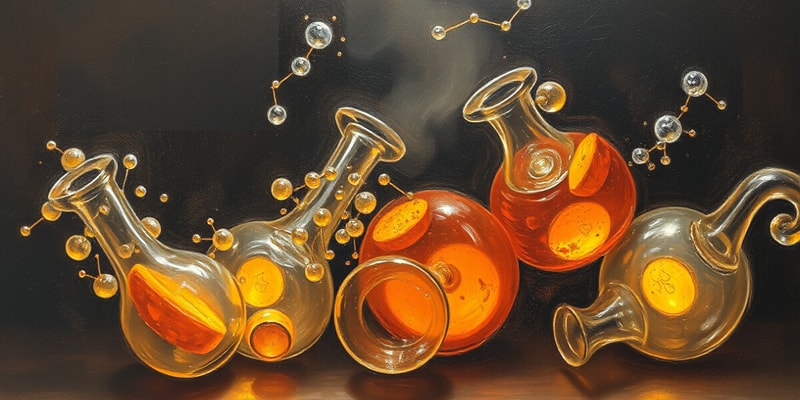Podcast Beta
Questions and Answers
When naming ionic compounds, the metal cation is listed ___
first
The charge of a cation in a compound must balance the charge of the ___
anion
The name of the compound formed from Na⁺ and Cl⁻ is ___
sodium chloride
The Roman numeral in the name of a compound indicates the ___ of the metal cation.
Signup and view all the answers
The compound formed from Cu²⁺ and SO₄²⁻ is named ___
Signup and view all the answers
When writing the formula for an ionic compound, the cation is always written ___
Signup and view all the answers
The name of the compound formed from Fe³⁺ and O²⁻ is ___
Signup and view all the answers
In the compound PbO, the lead ion is in the ___ oxidation state.
Signup and view all the answers
The formula for the compound formed from Ag⁺ and NO₃⁻ is ___
Signup and view all the answers
To determine the oxidation state of a multi-cation metal in a compound, you must consider the ___
Signup and view all the answers
The ionic compound formed from Mg²⁺ and Br⁻ is named ___
Signup and view all the answers
When naming ionic compounds, anions typically end with the suffix ___
Signup and view all the answers
The formula for the ionic compound formed from Sn⁴⁺ and Cl⁻ is ___
Signup and view all the answers
In the compound CoCl₂, cobalt has an oxidation state of ___
Signup and view all the answers
The name of the ionic compound formed from Al³⁺ and S²⁻ is ___
Signup and view all the answers
When forming ionic compounds, the total charge must be ___
Signup and view all the answers
The formula for the compound formed from Fe²⁺ and PO₄³⁻ is ___
Signup and view all the answers
In naming ionic compounds, if a metal can have multiple oxidation states, you must use a ___
Signup and view all the answers
The compound formed from Zn²⁺ and CO₃²⁻ is named ___
Signup and view all the answers
The name of the compound formed from Cr³⁺ and F⁻ is ___
Signup and view all the answers
The formula for the compound formed from Ni²⁺ and OH⁻ is ___
Signup and view all the answers
The oxidation state of manganese in MnO₂ is ___
Signup and view all the answers
The name of the ionic compound formed from V²⁺ and I⁻ is ___
Signup and view all the answers
When writing formulas for ionic compounds, the overall charge must equal ___
Signup and view all the answers
The compound formed from Ba²⁺ and PO₄³⁻ is named ___
Signup and view all the answers
Study Notes
Naming Ionic Compounds
- The metal cation is listed first when naming ionic compounds.
- The charge of a cation in a compound must balance the charge of the anion.
- The name of the compound formed from Na⁺ and Cl⁻ is sodium chloride.
- The Roman numeral in the name of a compound indicates the oxidation state of the metal cation.
- The compound formed from Cu²⁺ and SO₄²⁻ is named copper(II) sulfate.
- When writing the formula for an ionic compound, the cation is always written first.
- The name of the compound formed from Fe³⁺ and O²⁻ is iron(III) oxide.
- In the compound PbO, the lead ion is in the +2 oxidation state.
- The formula for the compound formed from Ag⁺ and NO₃⁻ is AgNO₃.
- To determine the oxidation state of a multi-cation metal in a compound, you must consider the charge of the anion.
- The ionic compound formed from Mg²⁺ and Br⁻ is named magnesium bromide.
- When naming ionic compounds, anions typically end with the suffix "-ide".
- The formula for the ionic compound formed from Sn⁴⁺ and Cl⁻ is SnCl₄.
- In the compound CoCl₂, cobalt has an oxidation state of +2.
- The name of the ionic compound formed from Al³⁺ and S²⁻ is aluminum sulfide.
- When forming ionic compounds, the total charge must be zero.
- The formula for the compound formed from Fe²⁺ and PO₄³⁻ is Fe₃(PO₄)₂.
- In naming ionic compounds, if a metal can have multiple oxidation states, you must use a Roman numeral to indicate the oxidation state.
- The compound formed from Zn²⁺ and CO₃²⁻ is named zinc carbonate.
- The name of the compound formed from Cr³⁺ and F⁻ is chromium(III) fluoride.
- The formula for the compound formed from Ni²⁺ and OH⁻ is Ni(OH)₂.
- The oxidation state of manganese in MnO₂ is +4.
- The name of the ionic compound formed from V²⁺ and I⁻ is vanadium(II) iodide.
- When writing formulas for ionic compounds, the overall charge must equal zero.
- The compound formed from Ba²⁺ and PO₄³⁻ is named barium phosphate.
Studying That Suits You
Use AI to generate personalized quizzes and flashcards to suit your learning preferences.
Related Documents
Description
Test your knowledge on the rules of naming ionic compounds in chemistry. This quiz covers essential concepts, including the order of cations and anions, Roman numerals for oxidation states, and common ionic compound names. Perfect for students learning about chemical nomenclature!




